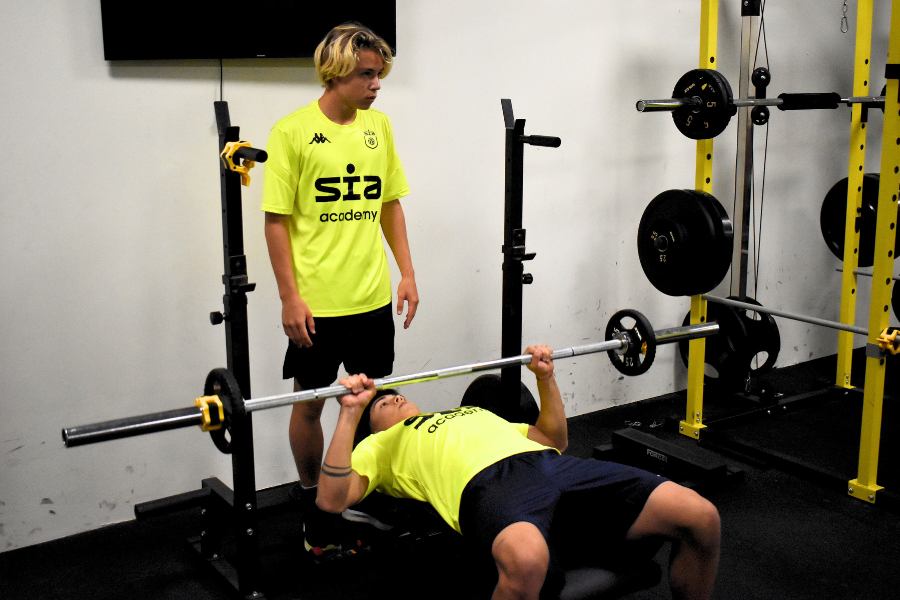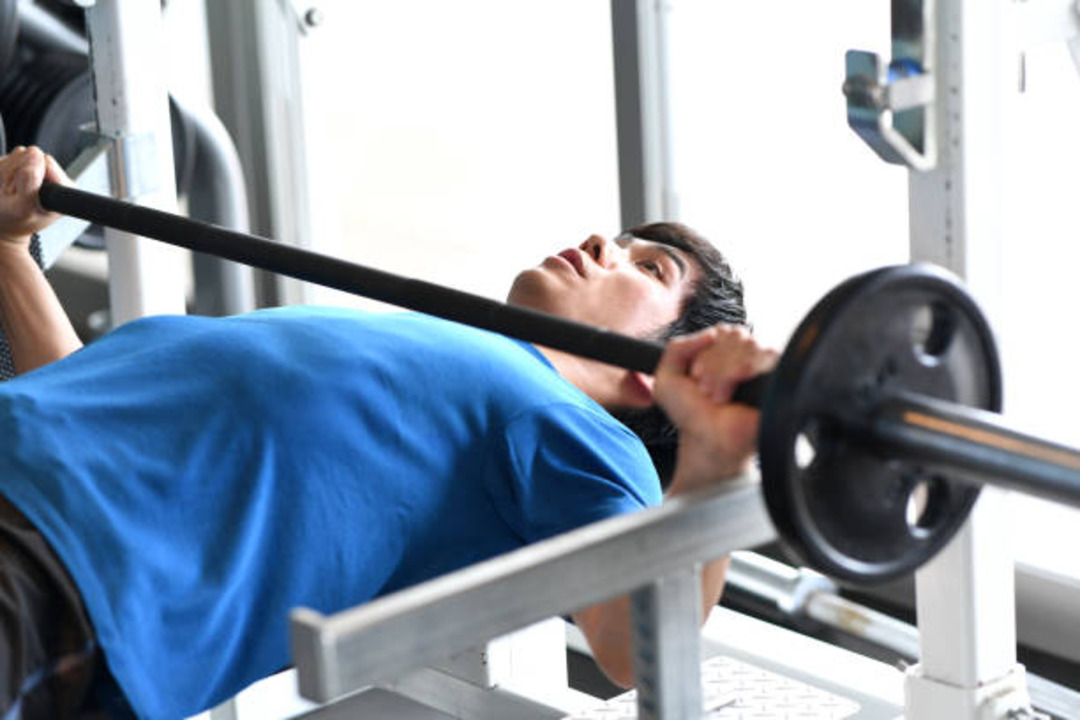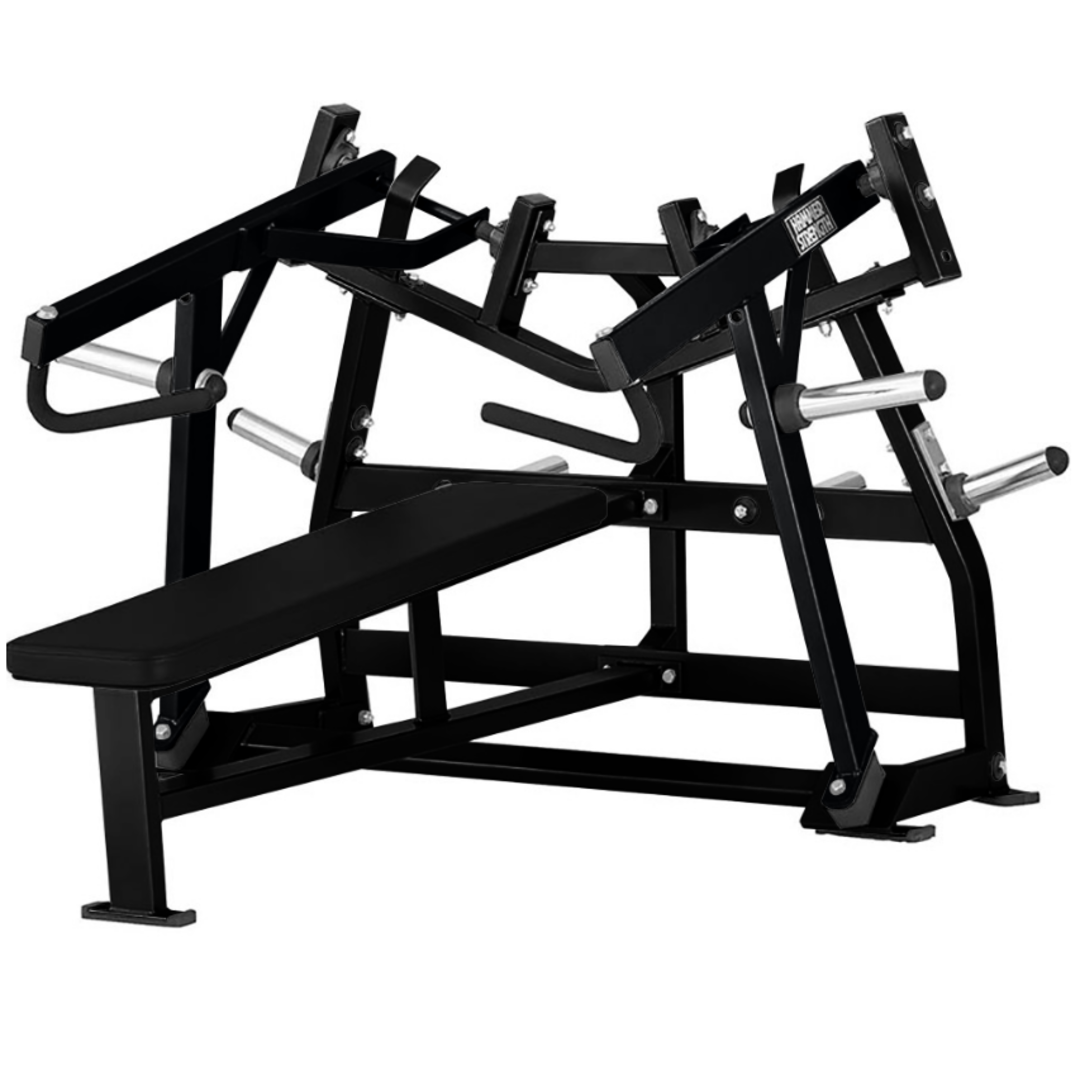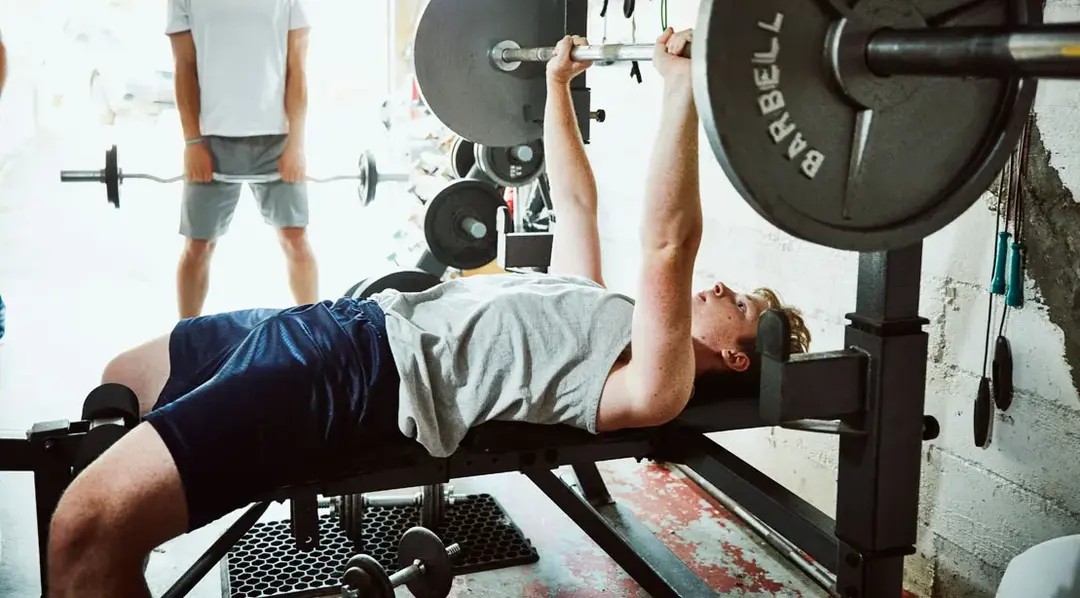What is the Average Bench Press By Age 16?

Discover the average bench press by age 16 and see how your strength stacks up. Learn what’s normal for teens and how to safely improve.
Is your bench press at 16 years old ahead of the curve or still finding its footing? Bench press numbers matter for teens using Best Fitness Apps because they set realistic goals, reveal technique gaps, and guide safe progress.
This guide explains typical teenage strength averages, one-rep max ranges, bodyweight bench press comparisons, and averages for both males and females, so you can clearly understand what typical bench press performance looks like for your age group. Want to know how many reps or how much weight matches your size and training history?
GetFit AI, an AI fitness app, turns those benchmarks into clear next steps with guided strength tests, simple technique tips, and a training plan built around your weight and experience.
Summary
- Bench press performance at 16 is highly variable, with no single target, and an average male benchmark of approximately 1.2 times body weight. A concrete example is a 130-pound teen averaging roughly a 156-pound bench, indicating that relative strength and sport background matter more than raw poundage.
- Biological maturation accounts for up to 30 percent of the variance in strength among 16-year-olds, and accumulated training time also plays a role, with athletes who have more than two years of experience able to bench press as much as 20 percent more than their less-experienced peers.
- Injury history should influence how you use benchmarks, favoring a controlled range of motion and pain-free reps, and structuring progress into short cycles, such as four to six weeks, with planned submaximal testing every 6 to 8 weeks to avoid setbacks.
- Program structure and daily readiness are critical. Aim for roughly eight to twelve high-quality top sets per week during strength phases. Use microloading in increments of 1 to 2.5 pounds when recovery begins to falter. Additionally, incorporate a deload that reduces volume by about 30 to 40 percent to facilitate supercompensation.
- Targeted technique and accessories move the needle more than extra random reps. For example, 75 percent of gym-goers reported an increase in bench press after using wrist wraps, and belt use can improve torso stiffness, with reported squat gains of up to 15 kg. Therefore, consider trialing an accessory for three to four weeks while tracking objective signals.
- Small objective checks can detect overload early. For example, a warm-up single that slows by 5 to 10 percent in velocity or feels two RPE points harder should trigger intensity reductions of about 5 to 10 percent. Monitoring sleep, morning resting heart rate, and a one-question readiness rating helps when two of these indicators drop.
- GetFit AI's AI fitness app addresses this by mapping athlete-proven routines to your injury profile, adjusting load, volume, accessory focus, and readiness checks based on RPE and velocity data.
What is the Average Bench Press By Age 16?

A 16-year-old’s bench press is a moving target, not a single number you should chase blindly. It depends on body weight, sport, and how consistently they train. In population terms, according to Gunsmith Fitness, the average bench press for a 16-year-old male is 1.2 times their body weight, which explains why raw poundage alone misleads more than it helps.
Why does the same age show so much range in strength?
Because strength scales with mass and training history, not age alone, for example, Gunsmith Fitness notes that for a 16-year-old male weighing 130 pounds, the average bench press is approximately 156 pounds. This illustrates how the same teen can sit far below or above population averages simply by weighing more or less. Sports background matters too: swimmers may develop pressing endurance, linemen build raw upper-body strength, and rowers load the posterior chain differently. Think of averages like a map grid, not a destination; they tell you where people cluster, not where you must land.
How should injury history change the way you use benchmarks?
This challenge appears across youth athletes and young adults: anxiety about the body feeling fragile, paired with frustration when progress stalls because of nagging injuries despite physiotherapy and good nutrition. If you carry recent shoulder pain or recurrent tendon issues, treating an average as a target invites setbacks. Prioritize controlled range of motion, technique checks, and slow load progression, and measure progress by the number of pain-free reps and an improved bar path, not just a single 1-rep max.
Most athletes follow generic “lift heavier each week” programs because they are familiar and straightforward. That works early on, but when growth plateaus and niggles appear, progress fragments—technique breaks down, recovery slips, and motivation takes the hit. Platforms like GetFit AI address this by mapping athlete-proven routines to your injury profile, then automatically adjusting load, volume, and accessory work while providing contextual coaching and chat support, which preserves progress without compromising safety.
What does a responsible progression look like in practice?
Start with short, measurable cycles: four to six weeks of consistent loading, followed by one formal maximum or repetition-maximum test at the end. Use submaximal tests to track velocity or bar speed when available, add targeted accessory lifts that address weak links, and treat technique as the primary variable when fatigue sets in. A helpful image: strength is a house built on many foundations, not a single pillar; pressing strength grows fastest when you shore up the shoulders, scapular control, and breathing as much as you add plates.
The frustrating part? This isn't even the most complex piece to figure out.
Related Reading
- Best Fitness Apps
- How Many Pull Ups Should I Be Able To Do
- Average Bench Press By Age
- Average Grip Strength Male
- Average Bench Press
- How Much Does A Bench Press Bar Weigh
- Average Male Bench Press
- How Much Can The Average Man Bench Press
Understanding Bench Press

The bench press is both a test and a tool: it measures upper-body pushing capacity while giving you multiple levers to increase that capacity, from programming choices to technical details and accessory work. You can change your bench numbers more quickly by adjusting your tempo, incorporating targeted weak-point work, and refining your test strength methods, rather than simply adding more weight.
How should a beginner structure progress?
Start with consistency and predictable overload, then add nuance. A simple eight-week block that staggers intensity works well: week one through three focus on building volume with controlled tempo, week four reduces load to allow for recovery, weeks five through seven push intensity with lower reps and higher bar speed, and week eight utilizes a submaximal test. For context, consult Instagram Reel by Dylan, "A beginner male lifter can expect to bench press approximately 135 pounds." as a practical anchor for initial program planning. Track RPE, not just plates, so you can auto-regulate when fatigue or life stress shows up.
What accessory lifts actually move the needle?
Address the sticking point, and your 1RM will improve. If your bar stalls off the chest, paused bench, tempo-controlled eccentric reps, and upper-chest work with incline dumbbells help. If the lockout is weak, add close-grip bench and heavy board or floor presses for 3 to 5 sets of 3 to 6 reps. Upper-back weakness responds to heavy rows and weighted scapular retraction drills, done twice weekly for 3 to 5 sets of 6 to 10 reps. Use accessory work as diagnosis, not decoration: one accessory exercise targeted correctly for eight weeks produces more precise results than three unrelated movements.
Where do people get misled, and why does it matter?
After coaching a 16-week high school strength cycle, the pattern was clear: many athletes equated big-looking bumper plates or flashy videos with actual strength, so they chased visual proof instead of measurable progress. That false signal encourages poor setup and sloppy reps, and over six weeks, it turned minor shoulder soreness into missed sessions. The deeper mistake is letting optics dictate progression instead of measurable outputs, such as rep quality, bar speed, and consistent load increases.
What breaks when training relies only on raw numbers?
Relying on a single max or one comparison snapshot creates brittle programming, especially during adolescence when growth, sleep, and school stress fluctuate. Percent-based programs fail when your actual daily capacity changes by 5 to 10 percent, which is why velocity or RPE-based auto-regulation is superior for sustained gains. Treat numbers as checkpoints, not commandments; adjust weekly volume and intensity based on movement quality and recovery signals.
Most lifters follow the familiar route of chasing heavier plates because it feels straightforward and visible. That works early, but it also buries the real cost: wasted sessions, missed weak-link training, and slow recovery when programming ignores day-to-day readiness. Solutions like GetFit AI map athlete-proven routines to your personal training history and recovery data, automatically adjust loads and accessory focus, and provide contextual coaching to reduce guesswork and compress trial-and-error into a single, coherent cycle.
How do minor technical tweaks change muscle recruitment?
Little changes shift which muscles do the work, and that determines where you get stronger. Narrowing grip moves demand more from the triceps, a slight incline shifts the upper-chest emphasis, and a longer, controlled eccentric increases time under tension for hypertrophy. Think of the bench like tuning a car suspension: minor adjustments to toe, camber, and shock damping either make the vehicle predictable or turn it into a twitchy mess. Test one tweak at a time for two to four weeks and measure the effect with bar speed or rep quality.
How should you test strength without breaking progress?
Avoid maxing out too often. Use 3RM or 5RM tests, velocity-based measures, or a planned RPE ramp every 6 to 8 weeks to estimate a 1RM safely. Warm up with progressive sets that include rehearsal with the exact grip and pause pattern, then take measured attempts that stop before technical breakdown. If a planned max attempt feels two RPE points harder than expected, stop and retest later; those signals are where innovative programs protect long-term gains.
That familiar confidence in a single number looks solid until you see what actually pushes the curve and what quietly pulls it apart.
Factors That Influence How Much a 16-Year-Old Can Bench Press

Strength comes from more than muscle and motivation. Limb geometry, tendon and bone maturity, neuromuscular control, and the cumulative time you’ve spent training all stack together, so two 16-year-olds who look alike can press very different numbers. These interacting factors explain why averages are a starting point, not a destination.
How do limb lengths and leverage change what feels heavy?
Longer arms increase the bar’s travel and reduce mechanical advantage, so a teen with long limbs must generate more force and control through a larger range of motion. Think of it as a seesaw: the farther your hands are from the fulcrum, the more force the lifter must produce to move the same weight. That’s why raw poundage under- or overstates ability unless you account for anthropometry, and why grip width and bar path matter more for some lifters than others.
What does maturation actually explain about differences between teens?
Biological maturation accounts for up to 30% of the variance in bench press strength among 16-year-olds, according to a 2025 study, "Factors associated with muscle strength in 10–16-year-old trained male children and adolescents." This means that the timing and tempo of puberty explain a significant share of why two athletes of the same age perform differently. Rapid growth spurts can temporarily decrease coordination and tendon stiffness, while earlier maturing teens often have greater bone density and muscle cross-sectional area that support heavier loading.
Why do neural skill and motor learning move the needle more than you expect?
Strength is partly a signal problem, not only a muscle problem. The nervous system must recruit motor units efficiently, sequence muscles correctly, and tolerate higher rates of force development. That’s why focused skill practice on set-up, breathing, and bar path can add pounds without increasing volume. This pattern appears across youth programs and among private athletes: when technique-driven coaching replaces random extra reps, lifters regain momentum, and stalled progress turns into measurable gains.
How much does accumulated training time matter?
Sixteen-year-olds with over two years of training experience can bench press up to 20% more than those with less experience, according to the same 2025 paper. This study demonstrates that sustained training leads to both structural and neural adaptations that persist beyond short-term programs. That explains the common frustration: disciplined nutrition and frequency are necessary, but they are not a substitute for months and seasons of progressively challenging, well-directed practice.
When everyday habits create a hidden cost
Most athletes follow simple routines because they are familiar and easy to track. That works for short bursts, but as training complexity grows, rigid one-size-fits-all plans fragment progress, and subtle limiting factors, such as leverage or maturation timing, get ignored. Solutions like AI-driven coaching platforms replicate athlete-proven routines, personalize load and technique cues, and adjust programming as an athlete’s recovery signals and training history change, preserving progress without the guesswork.
Which recovery and nutritional details are often missed?
Beyond calories and protein totals, micronutrients and circadian factors affect strength expression. Low iron or marginal vitamin D can blunt training responsiveness, and inconsistent sleep timing reduces neural drive on the day you need it most. The practical pattern is clear: athletes who track a few targeted markers, prioritize consistent sleep windows, and address deficits respond faster to the same stimulus than those who treat nutrition as only macronutrients.
How do psychology and arousal influence a single lift?
Bench performance is tightly tied to confidence, competition arousal, and risk tolerance. A nervous athlete with excellent technique will often fail a near-max bench because they tighten the wrong muscles or break the bar path. Training that exposes athletes to maximal-like conditions while teaching calm arousal control increases successful attempts more than piling on additional heavy sets.
Consider a lever that you can move, which changes multiple constraints at once; that is where program design must focus next.
Related Reading
- Bench Press Standards
- Do Pull Ups Work the Chest
- Symmetric Strength
- Average Deadlift Weight
- Grip Strength Norms
- 1 Rep Max Chart
- Average Male Deadlift
- Good Bench Press Weight
How to Improve Your Bench Press

You become stronger at the bench by stacking precise, small stresses while keeping the nervous system and joints healthy; that means microloading, innovative set organization, and objective readiness checks that allow intensity to rise without technique collapse. Do those three things reliably, and your monthly progress stops being a roll of the dice and becomes predictable.
How should I raise the load without crashing the recovery?
For many lifters, the blunt rule of "add weight each week" breaks when life stress or sleep shifts, so use microloading and controlled weekly volume instead. For true beginners, the idea to "Lift 10 pounds more each week" from GQ captures that rapid early-rate, but only while recovery, sleep, and movement quality are intact; if any of those drop, switch to 1 to 2.5 pound microplates and hold top sets steady until bar speed and RPE return to expected ranges. Think in terms of top sets per week, not sessions: target about eight to twelve high-quality top sets for your pressing muscles across the week during strength phases, then reduce that by 30 to 40 percent on a deload week to induce supercompensation.
What set structures actually raise bar speed and peak force?
Cluster sets and short-rest heavy triples give you the stimulus of near-max intensity without the exact accumulated metabolic toll as straight sets. A practical cluster protocol consists of five clusters, each comprising two repetitions at 85 to 90% of the maximum load, with 20 to 40 seconds between repetitions and 3 to 4 minutes between clusters. This approach preserves velocity while increasing load tolerance.
Pair those with accommodating resistance or short banded sets to overload the lockout while protecting the bottom of the lift, and you can hit higher bar speeds in submax work, which transfers to stronger one-rep attempts; some programs using these tactics have even been summarized with bold claims like "Increase your bench press by 20% in 8 weeks" in, but only when technical control and recovery are monitored.
Most lifters add plates because it feels productive, and that is understandable. Still, the hidden cost is mounting fatigue and small technical losses that compound into stalled progress and niggling injuries. Platforms like AI fitness app automate microloading, read readiness through RPE and velocity, and reassign accessory work automatically, so progression stays steady while reducing the months wasted chasing one-off maxes.
When should you back off, and how do you detect it early?
This problem consistently appears among beginners and intermediate lifters: you push frequency and intensity until warm-ups feel heavy, and then you try to "push through" instead of stepping back. Use simple objective checks, for example, if your usual warm-up single at a given weight slows by 5 to 10 percent in velocity or the same load feels two RPE points harder, reduce planned top-set intensity by 5 to 10 percent or swap in a recovery-focused session. Track sleep consistency, morning resting heart rate, and a one-question readiness rating before sessions; when two of these three drop, treat the workout as high-quality maintenance rather than progression.
How do you prime the nervous system so heavy singles become reliable?
Train the skill of the heavy lift with low-volume, high-salience practice that mirrors the maximal attempt. That looks like one to three heavy singles at 90 to 95 percent with complete rest once every 7 to 10 days, plus a separate speed day where you use 50 to 60 percent for fast triples and explosive cueing. This combination teaches the nervous system both to tolerate high force and to express it rapidly. It builds confidence under load, so arousal on test day turns into performance instead of panic. Treat this like tuning an instrument, not smashing it: minor adjustments matter far more than dramatic swings.
It's exhausting when progress stalls due to subtle fatigue; when that happens, simplify: fewer top sets, better sleep, precise microincrements, and an honest readiness check will help reset momentum.
Ready to train like the legends and finally achieve the body you've always wanted? GetFit AI's AI fitness app lets you follow the exact workout routines that made Arnold Schwarzenegger, Kobe Bryant, Cristiano Ronaldo, Serena Williams, and 11+ other elite athletes into champions, and you can chat with them whenever you need guidance or motivation.
That solution sounds tidy, but the next part reveals the one accessory choice that quietly determines whether those strategies actually stick.
Best Accessories to Boost Your Pressing Strength and Safety

Accessories alter how the bar travels and how your body tolerates the load, allowing you to increase pressing strength and reduce risk when used intentionally. Used as tools for specific phases and cues, belts, wraps, bands, shoes, and palm protection accelerate clean progress more than extra sets do.
Which accessory moves the needle the most when pressing on the strength?
When you need raw carryover on heavy singles, the belt is the single accessory that shifts force production, as it provides a predictable platform to brace from and transfer leg and trunk drive into the bar. Using lifting belts can increase your squat by up to 15 kg, which, in context, demonstrates how improved torso stiffness enables lifters to tolerate significantly higher loads. For pressing, this means safer top sets and more precise technical feedback. Practical rules, not myths: use a belt for singles and heavy triples, place it at the natural waist where you feel firm abdominal push, tighten until a strong brace is possible but you can still breathe into your belly, and keep belt use tied to intensity thresholds, for example during weeks you plan repeated top sets above about 85 percent of your measured capability.
How can you effectively use wrist wraps to achieve their benefits?
Stability first, crutch never, is the correct posture. Seventy-five % of gym-goers reported an increase in their bench press after using wrist wraps, which suggests that preventing excessive wrist extension reliably preserves force transfer during pressing movements. Choose a wrap length and stiffness suitable for the task, wrap to maintain neutral wrist alignment without forcing a rigid wrist, and use them on high-intensity sets or during peaking phases, rather than every accessory day, so your raw joint control continues to improve. If your warm-up singles and technique sets rely on wrist stability, leave wraps off to train the joint, then add them only when you need to protect structure while pushing near-max loads.
What role do bands, shoes, and gloves play in pressing mechanics?
Use resistance bands to adjust the load curve and overload lockouts or protect weak positions during technique work. Integrate them into specific training weeks for 2 to 6 weeks to train the nervous system to handle different speeds. Shoes matter for feet-driven benchers. Choose footwear with a firm, non-compressible sole so your leg drive remains consistent from session to session, and avoid heavily cushioned trainers that absorb force. Gloves provide hand protection but also reduce tactile feedback, so prefer thin palm guards or chalk for heavy pressing when grip feel matters; reserve thick padded gloves for high-rep accessory work where skin protection takes priority.
Most people treat accessories as styling, rather than strategy, and that creates hidden costs.
The familiar approach is to grab every gadget and wear them all the time because it feels safer. That works early, but as loads and frequency rise, habitual use can hide technical faults, mask readiness, and compound minor mobility problems into chronic pain. Solutions like GetFit AI provide contextual guidance on when to cue a belt, when to recommend wraps, and when to drop them, utilizing intensity, RPE, and training phase to maintain technique integrity while protecting peak efforts.
How should you introduce an accessory into a training block so that it helps, rather than masks?
Treat each item as an experiment with a short trial, for example, three to four weeks of targeted use while tracking objective signals, such as bar speed on a control lift, RPE drift, or consistency of bar path. If a belt or wrap allows you to raise the top-set load without increased technical breaks or pain, keep it for the peaking block. If movement quality degrades, revert and address the weak link directly. Think of accessories like tuning pegs on a guitar, minor adjustments that let the instrument play louder without the strings snapping.
When you combine intentional timing, measurable checks, and the right gear choices, accessories stop being props and become levers you control.
That one accessory choice will change how you train, and soon enough, you will want to know who can turn that setup into a complete, athlete-style program.
Make Your Favorite Athlete Your Fitness Trainer | Try GetFit AI's AI Trainer App for Free Today

We know that most athletes rely on generic targets because they are familiar and straightforward, and this approach works well early on; however, the same habit can obscure readiness signals and turn population averages into pressure instead of a practical plan. Platforms like GetFit AI replicate proven athlete routines, adjusting load, technique cues, and recovery to your profile. With the GetFit AI Website, 90% of users reported improved fitness levels within three months, and the app has garnered over 1 million downloads. You can try a tailored, accountable pathway that produces measurable gains without the guesswork.
Related Reading
- Average Deadlift Weight Kg
- Best Hiit Workout App
- Average Bench Press By Age 16
- Best Free Workout Apps
- Average Deadlift Weight For Male
- Best Workout Apps
- Average Bench Press Kg By Age
- Best Calisthenics Workout App
- Best Workout Tracker App
- Best Gym Workout App



.png)











